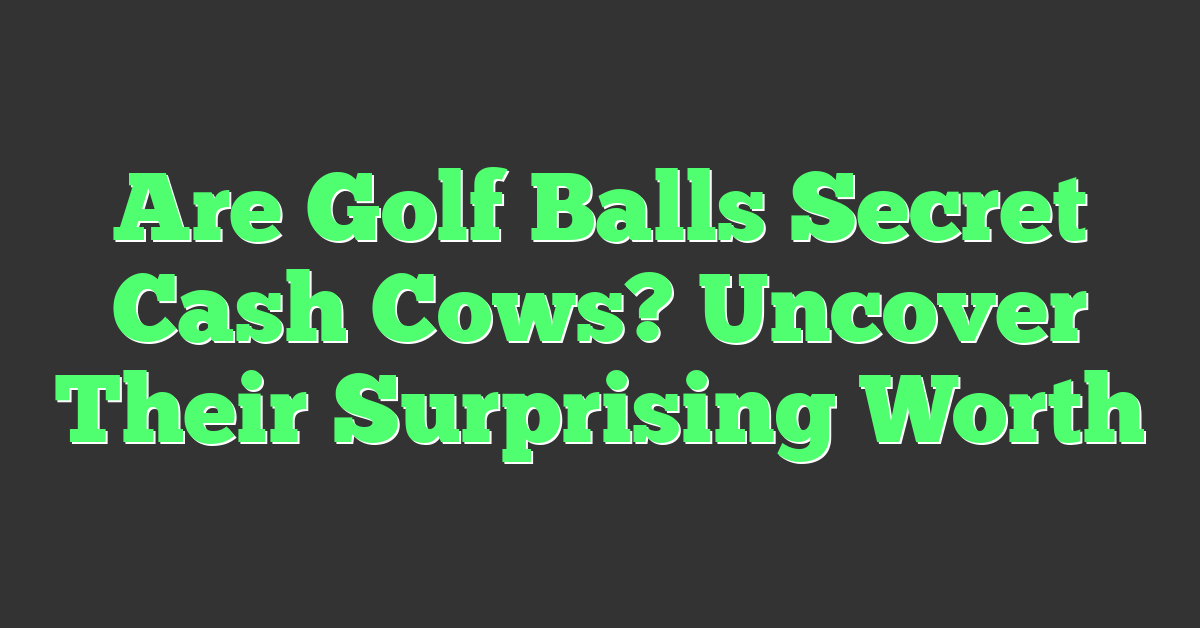You’ve probably seen your furry friend eyeing that stray golf ball in the yard with the same enthusiasm they have for their favorite chew toy. But before you let them tee off on a chewing spree, let’s talk about whether it’s safe for dogs to chomp down on golf balls.

It’s no secret dogs love to chew, and they’re not picky about what. However, when it comes to golf balls, there are a few things you should consider. The durability and size of golf balls might make them seem like an ideal toy, but are they really?
Potential Hazards of Chewing Golf Balls
When your dog gets hold of a golf ball, toxic materials might be your first concern. Most golf balls are designed with a core containing toxic chemicals, such as Zinc, which can lead to zinc poisoning if ingested in large quantities. The outer layer, often made from tough plastic or rubber, isn’t any safer if swallowed.
Remember, golf balls are engineered to withstand powerful impacts, making them incredibly durable. This doesn’t translate well to dog chew toys. Chewing on such hard objects can cause significant damage to your dog’s teeth. Fractures or chipped teeth aren’t just painful; they can also result in costly vet bills for dental work.
In addition to dental damage, there’s a risk of choking. Golf balls are about the perfect size to get lodged in your furry friend’s throat. Plus, when golf balls are chewed aggressively, they can break apart, creating choking hazards from the fragmented pieces.
Digestive obstruction is another serious risk associated with your dog chewing on golf balls. Should any piece of the ball be swallowed, it might get stuck in your dog’s gastrointestinal tract. This can lead to Vomiting, Abdominal Pain, or a more serious condition requiring emergency Surgery.
| Risk | Consequence |
|---|---|
| Toxic Materials | Zinc Poisoning |
| Hard Surface | Dental Damage |
| Ball Size | Choking Hazard |
| Broken Pieces | Internal Obstruction |
While it might be tempting to let your dog play with a golf ball, especially if it keeps them entertained, you must consider the possible implications. Always be watchful of the toys you provide to your loyal companion and opt for those specifically made for dogs, which prioritize safety and entertainment without the added risks.
Dental Damage Risks for Dogs
Chewing is a natural behavior for dogs, but not all chewable items are safe for your furry friend. Golf balls are particularly hazardous when it comes to dental health. The risk involved in letting your dog chew on golf balls comes from the hardness of the material.
Golf balls are designed to withstand powerful impacts from golf clubs. They’re tough enough to resist being compressed by a high-speed golf club swing, which can easily reach speeds of 100 MPH or more. This durability, however, means that they can also be incredibly harsh on your dog’s teeth. When your dog chews on such a hard object, it can lead to significant dental damage over time.
Here’s what you need to keep in mind:
- Fractured Teeth: The tough outer layer of a golf ball can cause your dog’s teeth to crack or break, potentially leading to painful dental fractures.
- Chipped Teeth: Regular chewing on any hard material can wear down the tooth’s surface, resulting in chips that may require veterinary attention.
- Tooth Wear: Over time, the abrasive surface of a golf ball can grind down the protective enamel on your dog’s teeth. This gradual wear can lead to sensitivity and pain.
- Jaw Stress: Chewing hard objects can strain your dog’s jaw muscles and joints, which might lead to more severe complications or conditions like TMJ (temporomandibular joint) disorders.
Veterinarians often report cases where dogs have worn down their teeth to the gum line after extended periods of chewing on inappropriate items. Such dental injuries not only cause pain and discomfort but can also affect your dog’s ability to eat properly. Although a dental injury might not be immediately apparent, signs such as drooling, pawing at the mouth, or reluctance to eat can indicate that your dog is suffering from a dental issue that needs professional attention.
Remember, the best practice is to provide toys made specifically for dogs—these are often softer and designed with your dog’s dental health in mind. They can endure the canine chewing behavior while being gentle enough to prevent dental damage. Choosing the right chew toy for your dog can be a simple yet effective step towards maintaining their overall health and happiness.
Choking Hazard and Intestinal Blockages
As someone who’s been around the links for a lifetime, you know that your skills on the course come with an understanding of every little detail, right down to the golf balls you drive down the fairway. But when you’re off the green and your four-legged friend is with you, it’s crucial to understand that golf balls pose a serious choking hazard for dogs. Not to mention, if a golf ball is chewed up and swallowed, it can lead to dangerous intestinal blockages that are no walk in the park.
Dogs are nimble and quick. Before you know it, those sharp teeth can puncture a ball, breaking it into smaller pieces that are easily swallowed. If you’re not vigilant, a casual chew can escalate to a life-threatening emergency. Smaller dogs are especially at risk, as the size of a golf ball is often a perfect fit to obstruct their airway.
It’s not just the choking; the real trouble begins if those pieces make it past the esophagus. Golf balls contain materials that aren’t digestible. A chunk of tough rubber or the hard plastic from the ball’s core could get lodged in your dog’s intestines. This type of blockage disrupts their digestive system and can quickly escalate to a need for surgical intervention. Consider these points:
- Dogs don’t digest golf ball material: It can stick around, causing irritation or blockage.
- Surgery is often required for removal: This is a costly and stressful process for both you and your dog.
- Prevention is key: Keep golf balls stored away and provide safe, dog-friendly toys instead.
Remember, while you’re working on shaving off those extra strokes to lower your handicap, your dog’s safety should always come first. Those seemingly harmless golf balls can quickly turn a relaxed day into an urgent vet visit. Keep the links for your game and the dog toys for your furry caddie. Your vigilance can prevent these hazards and keep your game day stress-free, at least off the course.
Toxicity Risks from Materials
When you’re out on the green, focused on shooting lower scores, it’s easy to forget that the small, dimpled golf ball you just launched down the fairway could hold hidden dangers for your furry friend back at home. As a low handicap golfer, you know the importance of every little detail in the game, and this attention to detail should carry over to the safety of the materials in your golfing equipment—especially if they land in your dog’s possession.
Golf balls are constructed with a variety of materials, many designed to enhance performance rather than safety. The core may contain heavy metals like lead or zinc, which are poisonous to dogs if ingested. While the risk of your dog puncturing the ball may seem low, considering your precise swing, it’s a possibility that can’t be ignored.
The external layer, known for giving you that perfect control and spin, might pose a risk as well. Surlyn or urethane, commonly used in modern golf ball covers, aren’t meant to be chewed. These materials are durable for play, yet if they’re consistently gnawed on by your dog, they can slowly break down, potentially releasing harmful chemicals.
Keep in mind that the dyes and paints used for the ball’s finishing might not be pet-friendly either. While they make your ball stand out against the green, these coatings aren’t designed for ingestion. As you aim to refine your game and lower your handicap, consider the potential ingestion of these toxic substances as an unintended hazard off the course.

To mitigate these risks:
- Store your golf balls in a secure location away from pets
- Check golf balls for signs of damage that could make them more accessible to curious canines
- Avoid leaving balls where dogs can reach them, similar to how you’d avoid hazards on the course
So the next time you clean out your golf bag or return from the driving range, take a moment to ensure your golf balls are stored safely away—your golf game won’t suffer, and you’ll be keeping your four-legged caddy’s health out of the rough.
Safer Alternatives for Chewing
Understanding the risks associated with dogs chewing on golf balls, you’re likely on the look-out for safer alternatives. After all, your furry friend’s safety is as important as nailing that next birdie.
Dog-specific chew toys are the go-to option. These toys are designed to withstand rigorous chewing and are made from materials that are non-toxic. When you’re out shopping for the right toy, keep in mind:
- Size and hardness: Pick a toy that matches your dog’s size and chew strength. You wouldn’t play with clubs that don’t fit your swing, and the same goes for selecting your dog’s toys.
- Interesting textures: Just as the grips of your clubs provide tactile feedback, dogs enjoy toys that have various bumps and ridges.
- Durable materials: Look for toys made from rubber or nylon, which can take a beating much like a quality golf glove.
Interactive toys can also provide mental stimulation, keeping your dog engaged while you’re perfecting your game. Products like treat puzzles are akin to strategizing your way through a tough course—they challenge the mind and reward problem-solving skills.

For those dogs that love fetching as much as you love a good drive, consider specially designed fetch toys. These options often have features that make them safer and more fun to chase, like unpredictable bouncing patterns that mimic the excitement of a wild shot. Always remember to:
- Supervise playtime, just as you would keep an eye on your swing and ball flight.
- Replace toys that show signs of wear, much like you’d regrip your clubs when they start feeling slick.
Chew treats, another alternative, can be beneficial if used correctly. Opt for natural, digestible options such as:
- Bully sticks
- Dental chews
- Rawhide alternatives
Much like choosing the best golf ball, consider your dog’s chewing habits and dietary needs when selecting chew treats. And always ensure they’re chewed under supervision, as even these can pose risks if large pieces are bitten off.
Choosing suitable chewing alternatives for your dog doesn’t have to be daunting. With a bit of knowledge and the right selection, both you and your companion can stay safe and savor the joys of playtime without any hazards coming in the way of your game or their health.
Conclusion
So there you have it. Your furry friend’s safety should always come first and steering clear of golf balls for chew time is a smart move. Remember to pick out toys and treats that cater to your dog’s chewing style and health needs. Keep an eye on them during play to catch any wear and tear early and always be ready to swap out the old for something new and safe. By doing so you’ll ensure countless hours of safe fun for your beloved pooch. Happy playing!











